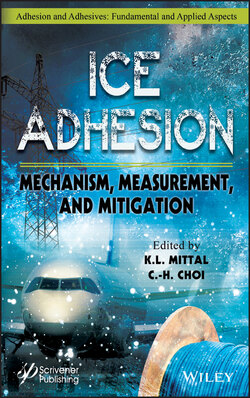Читать книгу Ice Adhesion - Группа авторов - Страница 46
3 Physics of Ice Nucleation and Growth on a Surface
ОглавлениеAlireza Hakimian, Sina Nazifi and Hadi Ghasemi1*
Department of Mechanical Engineering, University of Houston, Houston, Texas, USA
Abstract
Fundamental understanding of ice formation on a surface, i.e. heterogeneous formation, is critical to suppress ice accretion on the surfaces. Ice formation on a surface includes two steps of ice nucleation and further ice growth. As water droplet is placed on a sub-zero surface, with a time delay, ice nucleolus forms on the surface. Ice nucleation is governed by thermodynamics of ice-water-surface system and it is described by Gibbs energy barrier, ΔG*, which strongly depends on surface factor, f (m, x). Surface factor is a function of surface geometry, i.e. nano or micro, as well as surface free energy and through manipulating these parameters, ice nucleation can be controlled. After ice nucleation, ice further grows in a process which is controlled through heat transfer. Ice growth could be described by two extreme scenarios. In the first one, ice formation occurs with no airflow around where heat transfer through the substrate determines ice growth rate. In the second scenario, ice growth occurs in an environment with external airflow in which ice growth rate is controlled mainly by convective heat transfer. All of mentioned theories about ice formation on a surface are applicable for a single, isolated droplet. However, in reality existence of many droplets on a surface can interfere with ice nucleation and growth of droplets leading to ice bridging phenomenon which is a result of vapor source-sink behavior due to the vapor pressure gradient between a frozen droplet and adjacent liquid droplets.
Keywords: Ice nucleation, surface factor, Gibbs energy barrier, ice growth, surface free energy, ice bridging
